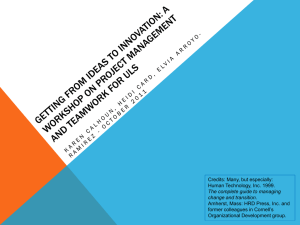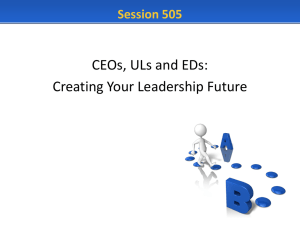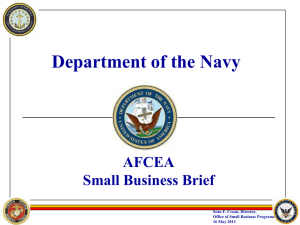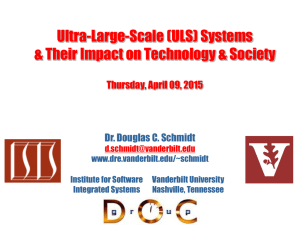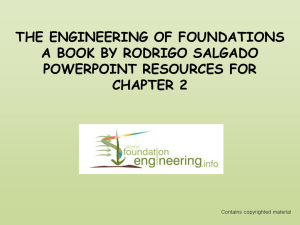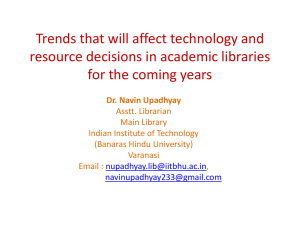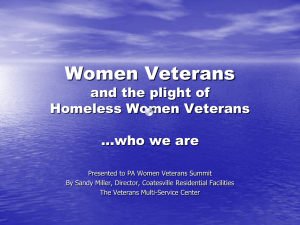- D
advertisement
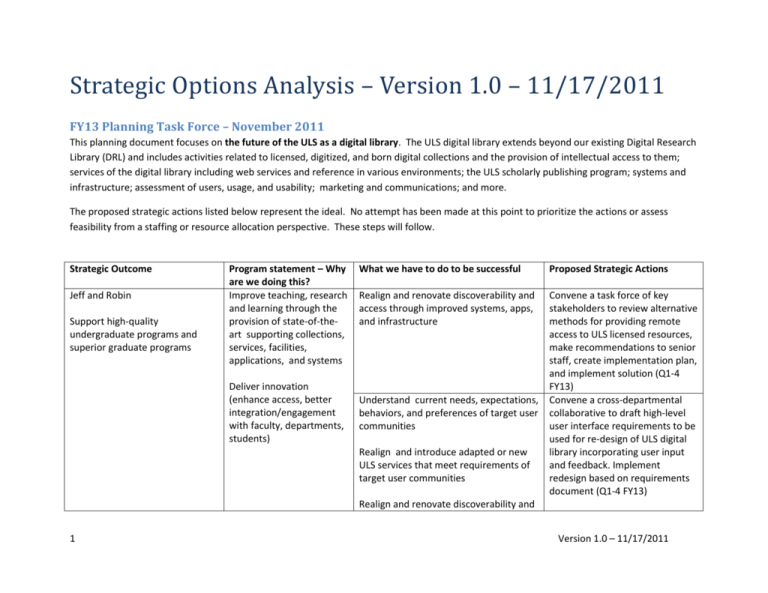
Strategic Options Analysis – Version 1.0 – 11/17/2011
FY13 Planning Task Force – November 2011
This planning document focuses on the future of the ULS as a digital library. The ULS digital library extends beyond our existing Digital Research
Library (DRL) and includes activities related to licensed, digitized, and born digital collections and the provision of intellectual access to them;
services of the digital library including web services and reference in various environments; the ULS scholarly publishing program; systems and
infrastructure; assessment of users, usage, and usability; marketing and communications; and more.
The proposed strategic actions listed below represent the ideal. No attempt has been made at this point to prioritize the actions or assess
feasibility from a staffing or resource allocation perspective. These steps will follow.
Strategic Outcome
Jeff and Robin
Support high-quality
undergraduate programs and
superior graduate programs
Program statement – Why
are we doing this?
Improve teaching, research
and learning through the
provision of state-of-theart supporting collections,
services, facilities,
applications, and systems
Deliver innovation
(enhance access, better
integration/engagement
with faculty, departments,
students)
What we have to do to be successful
Proposed Strategic Actions
Realign and renovate discoverability and
access through improved systems, apps,
and infrastructure
Convene a task force of key
stakeholders to review alternative
methods for providing remote
access to ULS licensed resources,
make recommendations to senior
staff, create implementation plan,
and implement solution (Q1-4
FY13)
Convene a cross-departmental
collaborative to draft high-level
user interface requirements to be
used for re-design of ULS digital
library incorporating user input
and feedback. Implement
redesign based on requirements
document (Q1-4 FY13)
Understand current needs, expectations,
behaviors, and preferences of target user
communities
Realign and introduce adapted or new
ULS services that meet requirements of
target user communities
Realign and renovate discoverability and
1
Version 1.0 – 11/17/2011
Strategic Outcome
Program statement – Why
are we doing this?
What we have to do to be successful
Proposed Strategic Actions
access through improved systems, apps,
and infrastructure
Embed collections and services at the
point of need
Increase awareness, perceived value,
relevance, and usage of ULS collections
Increase awareness, perceived value,
relevance, and usage of ULS collections
Realign and renovate discoverability and
access through improved systems, apps,
and infrastructure
Realign and introduce adapted or new
ULS services that meet requirements of
target user communities
Embed collections and services at the
point of need
2
Create integrated processes by
which end-users can recommend
content free of rights issues for
digitization (Q1-2 FY13)
Increase percentage of electronic
content available through patron
driven acquisitions, as informed
by FY11 pilot (by Q4 FY13)
Develop and implement pilot
program to make available ULS
created digital content for re-use
and/or remixing (Q3-4 FY13)
Convene task force with key ULS
and CIDDE stakeholders with goal
of greater integration of ULS
information literacy expertise and
ULS resources into CourseWeb
(Q1-2 FY13)
Version 1.0 – 11/17/2011
Strategic Outcome
Tim and Ed
Support the collaborative
advancement of knowledge and
creative endeavor
Program statement – Why
are we doing this?
Lead in transforming
patterns of scholarly
communication
Proposed Strategic Actions
Improve communications and branding
with target communities, both through
individual and organizational actions
Create and implement external
communications plans. Identify
responsibilities and mechanisms
for consistently distributing
targeted, relevant information to
ULS stakeholders (Q1-Q4 FY13)
Increase internal awareness of current
issues in scholarly communications
among ULS colleagues
Design and introduce professional
development programs for ULS
colleagues to inform external
communications on Open Access
and Scholarly Communications
(Q1 FY13)
Gain an understanding of the needs of
research faculty and other producers of
scholarly knowledge so we can better
respond to their needs
Directly engage faculty and
students on scholarly
communications issues through at
least 10 group events including
onsite visits with individual
schools and academic
departments (Q1-Q4 FY13)
Support researchers
in the production and
sharing of new knowledge
Select, organize, optimize
access to, preserve and
maintain the cultural
record, with emphasis on
unique collections of
special benefit to the
university and the citizens
of Pennsylvania
Seize the opportunity to
increase the global
visibility, quality, impact,
and open availability of the
advancements in
knowledge
3
What we have to do to be successful
{placeholder for E-Science
Institute project: Assess the role
of the ULS in E-Science initiatives
at Pitt, for example, by providing
data curation and other support
services}
Version 1.0 – 11/17/2011
Strategic Outcome
Program statement – Why
are we doing this?
What we have to do to be successful
Proposed Strategic Actions
Articulate a persuasive vision to help
knowledge producers become active
partners in transforming scholarly
communications
Advance open access policy with
the University administration and
other key influencers at Pitt,
resulting in adoption of Open
Access Policy by at least three
Schools or Responsibility Centers.
(Q1-Q2 FY13)
Promote awareness of Open
Access issues through Open
Access Web site
(openaccess.pitt.edu) and other
programmatic activities during
Open Access Week October 2228, 2012 (Q1-Q2 FY13)
Raise awareness, teach and train
scholars in current issues in scholarly
communications and best practices in
electronic publishing of scholarly
research
Develop and implement improved
Web presence and other
documentation for the University
community on key scholarly
communications issues including
copyright, Fair Use, Open Access
licensing, author rights and
responsibilities, and impact
assessment (Q1-Q4 FY13)
Support growth of Open Access
publishing while maintaining support for
academic integrity and quality of
scholarly research
Develop and master tools and systems
to support more innovative, efficient and
4
Continue to expand the ULS ejournal publishing program with
emphasis on incentivizing Open
Access; add at least 5 new titles
(Q1-Q4 FY13)
Comply with terms of
development partnership
Version 1.0 – 11/17/2011
Strategic Outcome
Program statement – Why
are we doing this?
What we have to do to be successful
Proposed Strategic Actions
cost-effective knowledge production
agreement with the Public
Knowledge Project (PKP) to
enhance OJS and other publishing
software in ways that benefit the
U. of Pittsburgh and our
publishing partners (Q1-Q4 FY13)
Develop efficient processes for
ingesting University research into
D-Scholarship@Pitt on a large
scale; add at least 3,000 new
records (by Q4 FY13)
Continued development of innovative
publishing services and trusted
repositories for the research output of
the University
Provide the technology
infrastructure and expertise to support
the creation of and access to new digital
collections
Ensure responsible stewardship of our
digital assets
Transition use of the Fedora
Commons infrastructure from
pilot to operational status; create
internal communication and
knowledge-sharing plans for
Fedora-based service and
stewardship capabilities. (Q1-4
FY13)
Develop policies governing
curation of digital objects (by Q4
FY13)
Conduct strategic planning
analysis for accessioning,
appraising, processing, preserving
and accessing electronic records
acquired by ULS Archives &
Special Collections (Q1-Q4 FY13)
5
Version 1.0 – 11/17/2011
Strategic Outcome
Tim and Ed
Program statement – Why
are we doing this?
Ensure organizational efficiency,
effectiveness and responsiveness
to university communities
Select ULS archival and manuscript
collections free of rights issues for
digitization to support primary University
disciplines, the citizens of Pennsylvania,
and the broader cultural record
Continue digitization of most
significant historic cultural
records (Q1-Q4 FY13)
Build collaborative partnerships with
faculty and research communities
around the world to improve the
production and sharing of scholarly
research
Increase the
communication of ideas
and collaborative action
between ULS staff across
departments and with
campus partners
Reduce organizational fragmentation
around digital library processes and
resources
Develop an organizational
culture that emphasizes
user-centered, data-driven
decision making and
continuous improvement
Promote and facilitate a
professional work
environment that is
6
Proposed Strategic Actions
Advance scholarship
worldwide
Expand international focus and
activities/ Support and engage
with diverse populations of
students and faculty
Aaron and Karen
What we have to do to be successful
Develop the necessary organizational
structures and cross-functional teams to
ensure:
Effective internal and external
communications
An inclusive and ongoing strategic
planning process
Strategic and prioritized allocation of
ULS resources
Collaborate with ULS liaison
librarians to engage faculty in the
selection of appropriate content
to be digitized (Q2-Q4 FY13)
Continue to work with publishing
partners worldwide, including
partners in Turkey, India,
Indonesia, Brazil, Peru, Bolivia,
UK, France, and others (Q1-Q4
FY13)
Establish and charge a cross-unit
ULS Digital Library Collaborative
to produce and carry out an
action plan for:
Identifying responsibilities
and mechanisms for
consistently distributing
internal and external
communications
Advancing collaboration with
campus partners
(Q1-Q2 FY13)
Review the organizational
structure of the ULS digital library
with a focus on efficiency and
Version 1.0 – 11/17/2011
Strategic Outcome
Program statement – Why
are we doing this?
challenging, satisfying, and
rewarding for staff at all
levels.
Increase service efficiency
and cost effectiveness.
What we have to do to be successful
Proposed Strategic Actions
support of strategic priorities and
make recommendations (Q4
FY13)
Introduce an annual cycle of formal and
informal user, usage, and usability
studies to inform user-centered design
for undergraduates, graduate students,
researchers and faculty
Identify, select, and conduct
relevant user, usage, and usability
studies (Q1-Q2 FY13)
Regularly assess and update staff
competencies
Create and implement an
assessment tool to determine
staff competencies and gaps, and
to support the alignment of skills
with organizational priorities (Q1Q2 FY 13)
Provide targeted resources to support
technical training and professional
development needs
Informed by these studies, review
current ULS digital library services
and partnerships and develop, in
writing, a prioritized plan and
roadmap for the next 2-3 years.
(Q1-Q3 FY13)
Create and implement a targeted
professional development
program for staff, informed by
assessment, to strengthen
prioritized skills (Q3-Q4 FY 13)
7
Version 1.0 – 11/17/2011
Strategic Outcome
Program statement – Why
are we doing this?
What we have to do to be successful
Proposed Strategic Actions
Identify and capitalize on partnerships
and collaborations outside the university
that can increase our organizational
efficiency and effectiveness
Conduct a review of ULS
partnerships with digital library
implications
Identify a ULS liaison for
each partnership; duties
include regular reporting
back to ULS
Cross-check partnership
benefits and services
against ULS digital library
strategic priorities;
identify opportunities and
develop action plans
(Q1 FY13)
Design, document, implement,
and train selected staff in a
project management framework
(Q1-Q3 FY13)
Create and implement a project
management framework to ensure
strategic focus; successful and on-time
outcomes; effective marketing, outreach
and communications; and the use of
assessment data to underpin digital
library initiatives
8
Add current and ongoing user
assessment and feedback data to
the Assessment Sharepoint site
(Q1-Q4 FY13)
Version 1.0 – 11/17/2011
